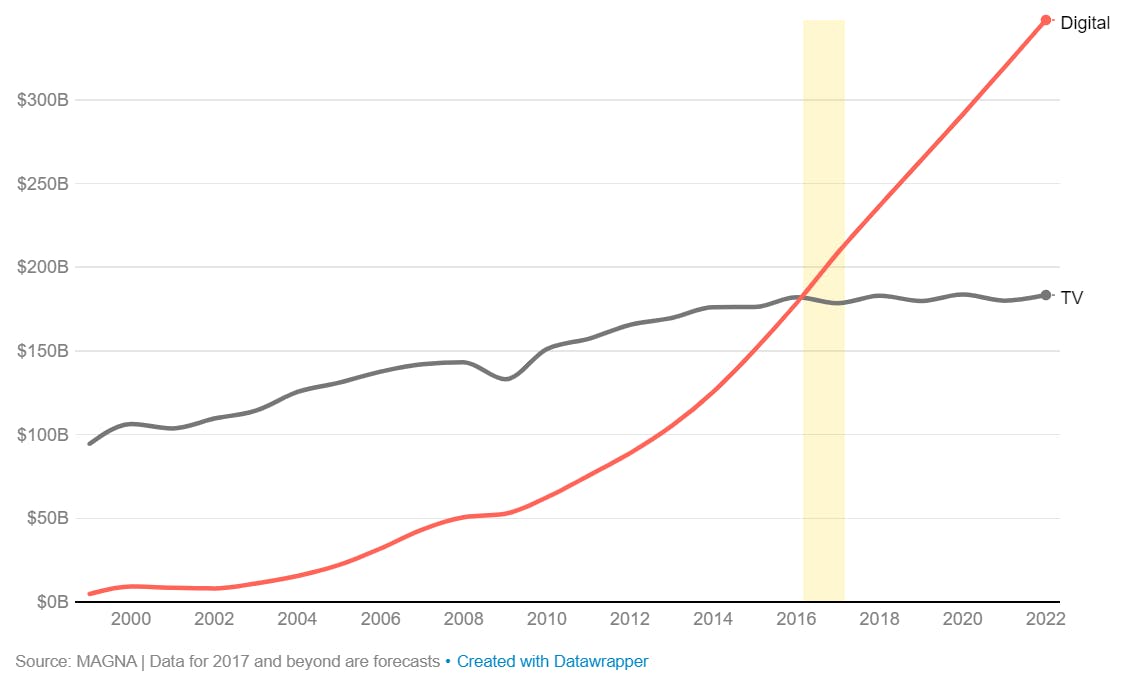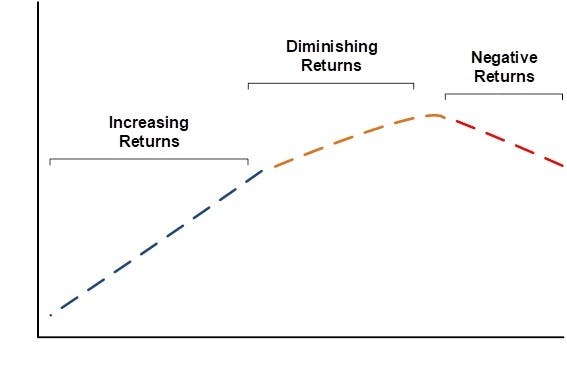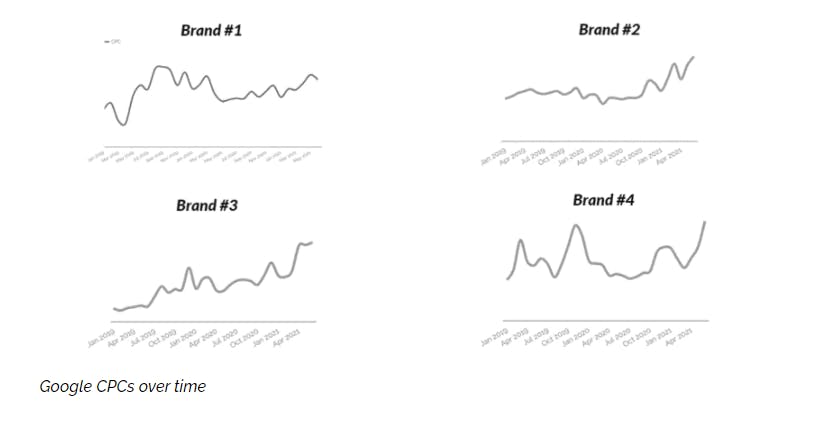Brand vs Performance Marketing: Where Should I Invest My eCommerce Budget?
Every industry goes through constant evolution and working in marketing or media is no different.
Back in the 2000s marketing strategy had focused heavily around media planning with brands driving awareness through above the line marketing.
In the last 5-10 years, the pendulum has shifted towards performance marketing, with global digital spend outstripping TV for the first time in 2017, allowing marketers to better understand the impact of investment and plan strategically using the vast amount of new data available.

What was a steady acceleration towards performance marketing turned into a foot-to-the-floor rush to put more budget into Google, Amazon, Facebook & Instagram, where there was more control and measurable ROI that makes FD’s and CFO’s much easier to please.
Slashing brand awareness budgets became the obvious preservation strategy because of COVID-19, particularly as customers flocked to shopping online as there was no alternative.
So, is there still a place for brand marketing campaigns in an eCommerce brand’s strategy when the value from this kind of investment is much harder to prove?
1. Fill from the bottom with performance marketing…
With less ‘fluff’ and the ability to easily link back to commercial impact, channels like Google Ads, Google Shopping, Amazon and Paid Social are the place to start.
With a much lower barrier to entry in the market, brands can invest anywhere from £50-£500,000 with the flexibility to increase and reduce depending on subsequent return.
There’s an awesome amount of control over audience profiling, whether through Facebook’s rich amount of consumer data or the laser-focus you can place on search-based targeting on Google.
If performance is good, you can swiftly push budget to profitable campaigns, or if category demand is down or CPMs are too high, activity can easily be paused while you weather the storm.
The most common question we get asked these days by Marketing Managers…
The answer to this is tricky.
Issues can begin to arise when brands saturate performance channels, particularly D2C native brands who adopted this approach from day one.
Once a brand has captured everyone reachable within the acquisition stage and all the low hanging fruit is gone, additional spend is likely to return at a loss.
A brand might be spending £50k per month, be happy with the ROI and want to spend more, but a point of diminishing returns can kick in...
£50K at 4x ROAS = £200K revenue
You decide to increase the monthly budget by £10k and see results of...
£60K at 3.5x ROAS = £210K revenue
So even though you might be happy with a 350% return, you're actually paying £10K extra to get £10K back - meaning the extra spend isn't doing much.
At this point of diminishing returns, there are smarter ways to spend your money.

2. Fill from the top with brand marketing…
When this happens it’s time to invest that money elsewhere and grow brand demand through programmatic display & video, digital OOH, influencer marketing and digital PR.
Straight away it’s worth laying some ground rules:
- Brand marketing is A LOT harder to measure. Smart marketers can still do it, but you don’t have the laser-focus & level of confidence of performance channels.
- It’s a much harder sell on a P&L. You’ll need to go armed with charts showing you’ve hit the point of depreciation on your performance channels and the potential impact of brand activity. Fortunately with acquisition costs going up, largely driven by rising CPMs on Social & Search, now is the time to have these conversations.

Reload data.
- Brand marketing is about fuelling your performance channels. Scaling Google spend will become a lot easier if the number of people searching for your brand is going up as a result of brand activity.
- This is a long term strategy. Depending on your organisational culture, changing the way of thinking, from chasing weekly targets to baking in the foundations for the long term isn’t for the faint-hearted.
If your brand hasn’t done a great deal of brand marketing, the below should allow you to start pushing more budget to top of the funnel channels with confidence.
3. Know what “success looks like” by going in and creating Prospect Criteria...
If you’re unable to measure direct return, brands must focus on other metrics and leading indicators that demonstrate the impact on the rest of the purchase journey and the final purchase. It's actually a concept that B2B marketers have been employing for years to great success.
At Reload we call this ‘prospect criteria’, the process of deciding what’s realistic for a customer at the early stages of their purchase journey and how we can measure this online. What behaviours will users exhibit after being served a brand ad in order to qualify them as a ‘prospect’ who given time, is likely to buy?
Take a programmatic “brand heat” campaign, you’ll need to evaluate what‘s expected? After watching an in-stream video ad, is it realistic to expect somebody to click through to the website? Maybe not.

Wrangler Programmatic Ads.
But you would expect them to watch over 50% or even 75% of the video. Say a 30 second video received 250k impressions (sounds impressive right?!) but digging deeper only 8k people watched over 20 seconds, that’s a pretty low engagement rate and based on your level of spend, you may deem 8k of potential prospects wasn’t a good return.
Every activity is different. For a paid advertorial or website takeover, the expectations will be different again.
How much did the user read and engage with? Did they read, click-through or just scroll right past? Here you’re likely looking for a click through to your website, meaning that all of a sudden we have a heap more data to play with.
Here we’d be establishing a segment in your website analytics to track:
- Users who arrived via the specific brand campaign
- Didn’t bounce but viewed at least 3 pages
- Spent over 60 seconds on a product page

Over time you want to tweak and add to your prospect criteria to fit your appetite (using add to carts, store locator finders, live chat engagement) to layer up your expectations of customers.
Just as there’s a difference between one customer walking straight out of a bricks & mortar retail store after goggling at the prices, compared to a different customer, spending 5 mins trawling the aisles, taking a few items to the changing room and asking questions of a store assistant, when analysing digital brand activity, there’s a difference between a good impression and a bad impression.
This is prospect criteria.
4. If you’re still struggling to know what activity is driving what results, it's time to find answers once and for all…
Turn off all brand activity.
No, really. Do it.

Source: Pinterest.
Going dark on your advertising channels may seem drastic but it’s a sure-fire way to see what impact it actually drives. Here it’s important to set up your hypothesis like a scientist would and do what you can to make it a “fair test”. Ensuring results won’t be compromised by other factors such as seasonal demand changes, promos or product launches, stock issues etc… and narrowing in on the key channel or campaign you want to review.
What are you looking for from an experiment like this? Brand activity typically impacts the following:
- Number of people searching for your brand
- People landing on the website homepage
- People arriving via the Direct channel in your analytics
- Store visits
So the aim is to benchmark all of these before and after you went dark, to understand the actual impact.
Depending on the length of your purchase journey (for example, fast fashion will move quicker than a luxury or premium purchase) you may need to turn brand activity off for longer to see the true impact
We’ve done plenty of these experiments over the years and it’s worth compromising 1-2 weeks of results for the ability to make more informed decisions over the next 1-2 years.
And for us at Reload, that’s what our approach is.
We set up campaigns and channels strategies that deliver answers as well as results. Aiming to drive immediate performance but also to ensure that we're thinking long term about how a brand can scale.
Keen to talk more about this?
Talk to one of our team today.
Or if you’re wanting to read more, take a look at our other articles to find more industry insights from Reload.
